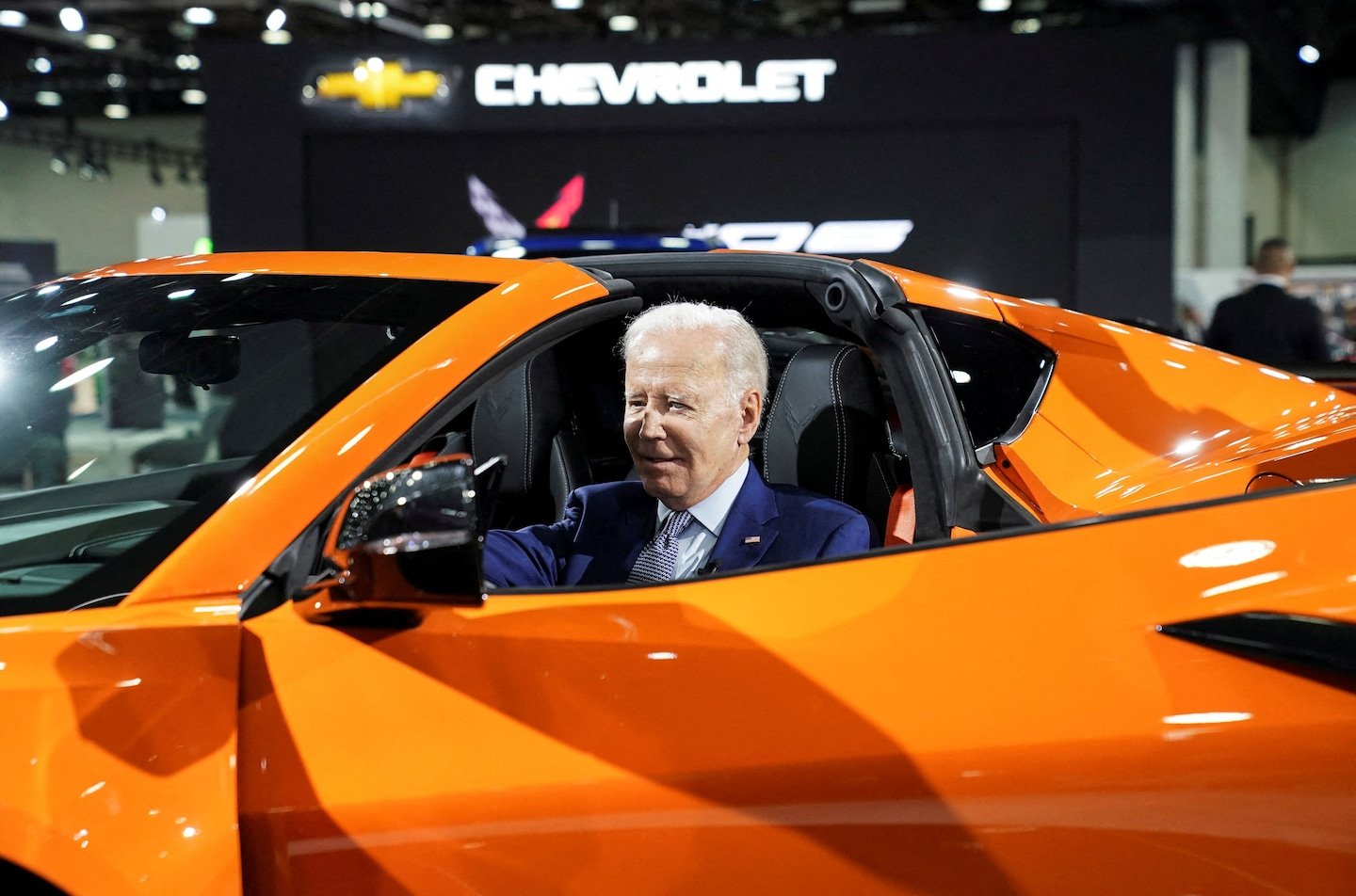But unlike last year’s proposed rule, automakers would not need to dramatically boost electric vehicle (EV) sales until after 2030. The delayed timeline reflects an election-year concession to labor unions, a key Democratic constituency that has raised concerns about a rapid shift to EVs.
In another change from the proposal, automakers could comply by boosting sales of plug-in hybrid vehicles in addition to all-electric vehicles. Plug-in hybrids have recently proved more popular with U.S. consumers, in part because of concerns about a lack of public charging infrastructure.
The final rule will still prevent 7.2 billion metric tons of carbon emissions from entering the atmosphere through 2055, according to the EPA. It will also reduce fine particulate matter and nitrogen oxides, preventing up to 2,500 premature deaths from air pollution annually starting in 2055, the agency said.
“Our final rule delivers the same — if not more — pollution reduction than we set out at proposal,” EPA Administrator Michael Regan said on a call with reporters Tuesday previewing the announcement. “These final standards will also reduce some of the most serious pollutants that impact public health.”
Republican-led states and fossil fuel companies are likely to challenge the rule in court. But the Alliance for Automotive Innovation, a trade group whose members include Ford, General Motors, Stellantis and Toyota, praised the EPA’s decision to delay the stricter EV requirements until after 2030.
“Moderating the pace of EV adoption in 2027, 2028, 2029 and 2030 was the right call,” John Bozzella, president and CEO of the alliance, said in a statement. “… These adjusted EV targets — still a stretch goal — should give the market and supply chains a chance to catch up.”
U.S. EV sales have cooled in recent months. According to estimates from Kelley Blue Book, U.S. EV sales increased year-over-year by 40 percent in the fourth quarter of 2023, down from a 49 percent jump in the third quarter and a 52 percent spike in the second quarter.
Yet Albert Gore, the executive director of the Zero Emission Transportation Association and the son of former vice president Al Gore, said other figures paint a more encouraging picture. He noted that a record 1.2 million EVs were sold in the United States last year, bringing EVs’ market share to 7.6 percent in 2023 compared with 5.9 percent in 2022.
“Whether or not we’re talking about a real slowdown, the trend line for EVs has been one of phenomenal growth over the last couple of years,” Gore said.
The price of EVs is also plunging so fast that they’re now almost as cheap as gas-powered cars. The average price difference last month was $5,000, according to data from Cox Automotive.
Still, the recent sales slowdown has prompted some automakers to scale back their EV plans, with Ford slashing production of the much-touted F-150 Lightning electric pickup truck. Many automakers are now pivoting to better-selling plug-in hybrids — a compromise between the internal combustion engines of the past and the batteries of the future.
Wednesday’s rule comes after a contentious back-and-forth between the United Auto Workers and the Biden administration over whether — and how — the shift to EVs will benefit workers.
In September, the UAW launched a historic strike against Detroit’s three biggest automakers — Ford, General Motors and Stellantis. The workers warned that the rise of EVs could erase well-paying jobs in the auto industry, since many EV plants are being built in Southern states less friendly to union labor.
Despite these warnings, the EPA issued an ambitious proposed rule last April that called for EVs to account for 67 percent of all new passenger car and light-duty truck sales by 2032. Weeks later, UAW President Shawn Fain wrote that the union was withholding its endorsement of Biden’s reelection campaign over “concerns with the electric vehicle transition.”
Yet the union reversed course and coalesced around Biden after the EPA signaled it would relax the timeline in the final rule. The UAW endorsed the president at its annual legislative conference in January, and Fain attended Biden’s State of the Union address this month.
Automakers could still comply with the final rule by making EVs account for 67 percent of new car sales in 2032, according to the EPA. But they could also meet the requirements by making all-electric vehicles account for 56 percent and making plug-in hybrids represent 13 percent, the agency said.
Former president Donald Trump, the presumptive Republican presidential nominee, has called Fain a “dope” and has repeatedly bashed Biden’s EV goals. He has falsely claimed that EVs cannot travel far on a single charge, and he has pledged to scrap the EPA rule on day two of a second term.
On Monday, Trump sought to defend his declaration over the weekend that there would be a “bloodbath” if he lost in November, claiming he was merely describing a bloodbath for the auto sector. He wrote on his social media platform that he was “simply referring to [EV] imports” allowed by Biden, which he said “are killing the automobile industry.”
Manish Bapna, president and CEO of NRDC Action Fund, the political arm of the Natural Resources Defense Council, criticized Trump’s anti-EV rhetoric.
“The industry is betting its future on electric cars, drivers are buying them in record numbers and last fall’s UAW agreement makes sure workers benefit,” Bapna said in an email. “Biden’s got a strategy to support that shift. Trump wants to slam it into reverse.”
The fossil fuel industry has sought to drum up opposition to the EPA rule, which could eat into demand for its petroleum products. The American Fuel & Petrochemical Manufacturers (AFPM), an industry trade group, has launched a seven-figure campaign against what it calls a de facto “gas car ban.” The campaign includes ads in battleground states warning that the rule will restrict consumer choice.
“To be sure, the administration refers to these regulations as ‘standards,’ not ‘bans’ or ‘mandates,’” AFPM President and CEO Chet Thompson said on a call with reporters this month. “But they do that because they know how unpopular bans are with Americans.”
The AFPM’s members include fossil fuel giants such as ExxonMobil, Chevron, Marathon Petroleum and Valero Energy. Marathon Petroleum, the nation’s largest refiner, waged a covert campaign in 2018 to roll back the car emissions standards set by President Barack Obama.
Mike Sommers, chief executive of the American Petroleum Institute, said the oil industry lobby group plans to challenge the new standards in court. “We’ll do everything we can to stop the rule,” he said in an interview Wednesday at an energy conference in Houston.
California regulators are going further than the EPA, seeking to end statewide sales of new gas cars by 2035. In the past, more than a dozen other states have opted to follow California’s tougher tailpipe pollution rules.
The California Air Resources Board announced Tuesday a deal with Stellantis, the owner of the Jeep and Ram brands. Under the deal, Stellantis agreed to comply with California’s EV sales requirements even if they are blocked by a court or a potential second Trump administration.
The automaker had previously blasted those requirements for handing rivals an unfair advantage. But on Tuesday, Stellantis CEO Carlos Tavares called the agreement a “win-win solution” that will avoid 10 million to 12 million metric tons of greenhouse gas emissions through 2030.
“The biggest and most influential companies in the world understand that this is how we can fight climate change together,” California Gov. Gavin Newsom (D) said in a statement.




